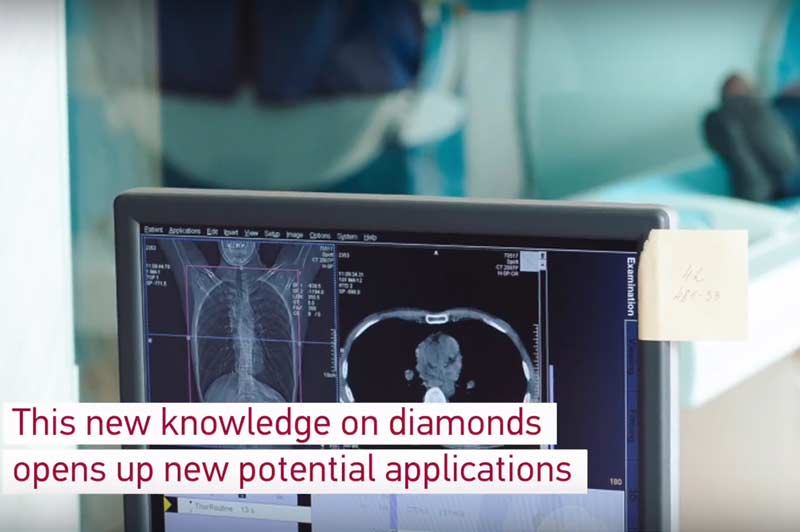
An international interdisciplinary team of scientists [1] that includes Prof Subra Suresh, President of Nanyang
Technological University, Singapore (NTU Singapore), demonstrated
that diamond, the world’s hardest natural material, is also flexible when made
into nanoscale needles. This discovery may lead to new applications in
bioimaging and biosensing, drug delivery, data storage, opto-electronic devices
and ultra-strength nanostructures.
Up to 9% tensile
stretch
The diamond nano-needles – about a thousand times thinner
than a strand of human hair – can be bent and stretched up to nine per cent,
before bouncing back to their original state when pressure is removed. This
is significantly greater than the flexibility of bulk diamond in sizes visible
to the naked eye. The latter is expected to stretch by well below one per cent.
Other strong and brittle materials also usually break when attempts are made to
flex them.
The nano-needles were grown through a special process called
chemical vapour deposition and etched into final shape. The team used a diamond
probe to put pressure on the sides of the diamond nano-needles, recording the process
in real time using a scanning electron microscope. The researchers measured how
much each needle could bend before it fractured.
“Our results were so surprising that we had to run the
experiments again under different conditions just to confirm them,” said Prof
Suresh.
Prof Suresh explained that this this is a demonstration that
what is usually not possible at the macroscopic and microscopic scales can
occur at the nano-scale, where the entire specimen consists of only dozens or
hundreds of atoms, and where the surface to volume ratio is large.”
The team ran hundreds of detailed computer simulations
alongside their experimental tests to understand and explain how the diamond
needles underwent large elastic strains. They learnt after two years of
iterations between simulations and real-time experiments that the deformed
shape of a bent nano-needle is the key in determining its maximum tensile
strain achieved. The controlled bending deformation also enables precise
control and on-the-fly alterations of the maximum strain in the nano-needle,
below its fracture limit.
In addition to showing up to 9% tensile stretch in
single crystal diamonds, Prof Suresh and his collaborators also showed that
polycrystalline diamond nano-needles, where each needle comprises many
nano-size grains or crystals of diamond, can withstand a reversible,
elastic stretch of up to 4% before breaking.
Applications
When elastic strain exceeds one percent, quantum mechanical
calculations in previous theoretical studies indicate significant physical or
chemical property changes. Hence, this demonstrated ability of introducing
elastic strains in diamond by flexing it up to 9% provides opportunities for fine-tuning
its electronic properties. This phenomenon could also be used to tailor
mechanical, thermal, optical, magnetic, electrical, and light-emitting
properties to design advanced materials for various applications.
The nano-diamonds could help design of better ultra-small
biosensors for greater performance.
Another application area of particular significance is the
nitrogen-vacancy (NV) emission centres in diamond. The NV centre consists of a
nearest-neighbor pair of a nitrogen atom, which substitutes for a carbon atom,
and a lattice vacancy. It is one of the point effects in diamond, which are Imperfections
in the crystal lattice of diamond. NV Centres are extremely sensitive to
magnetic fields, temperatures, ion concentrations and spin densities. Since
changes in elastic strains are sensitive to magnetic fields, potential
applications could include such fields as data storage where lasers could
encode data into diamonds.
In biosensing applications, NV could also be used in
Magnetic Resonance Imaging (MRI) or Nuclear Magnetic Resonance (NMR) to achieve
even higher accuracy and resolutions, as well as 3-dimensional imaging for
complex nanostructures and biomolecules.
As diamonds are biocompatible, they could also be useful for
drug delivery into cells where strong yet flexible nano-needles are
needed.
This discovery also shows new pathways for producing novel
diamond architectures for mechanical applications, as well as a variety of
functional applications in devices, biomedicine, imaging, micro-testing, and
materials science and engineering.
[1] The findings
were published on 20 April in the journal Science. The interdisciplinary team included
Prof Subra Suresh, President and also Distinguished University Professor at NTU
Singapore, as senior author. Other corresponding authors include Prof Yang Lu
and Prof Wenjun Zhang from the City University of Hong Kong, Dr Ming Dao from
the Massachusetts Institute of Technology (MIT) in United States, with other co-authors
from Hong Kong, United States and South Korea.
In addition to Drs. Subra Suresh, Yang Lu, Weijun Zhang and
Ming Dao, the list of authors includes: Amit Banerjee (lead author), Hongti
Zhang (co-lead author), Muk-Fung Yuen, Jianbin Liu, and Jian Lu from the City
University of Hong Kong; Daniel Bernoulli (co-lead author) from MIT; Jichen
Dong from the Institute for Basic Science, Ulsan, Korea; and Feng Ding from the
Ulsan Institute of Science and Technology, Korea.
















